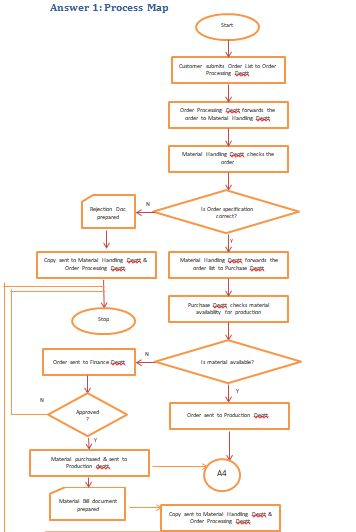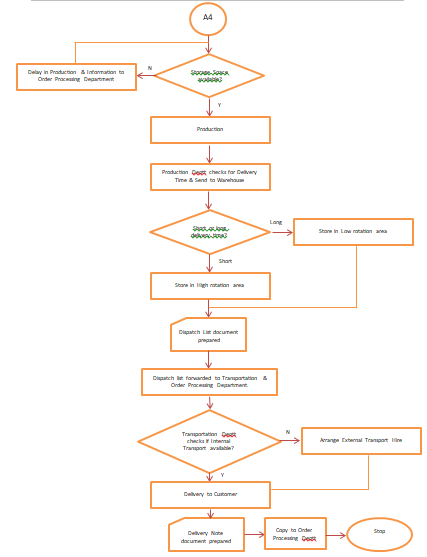- Home
- Free Samples
- Research Methods
- BUSSB2012 Case Of Sindbad Logistics F...
BUSSB2012 Case of Sindbad Logistics for Receiving Customer Order: Research Method Assessment Answer

| IN SEMESTER (INDIVIDUAL) ASSIGNMENT | |
| Module Code: BUSS-B2012 | Module Name: Research Methods, data Analytics and PP |
| Level: 2 | Max. Marks: 100 |
LO Covered
- Design a project plan for business improvement.
- Execute reliable research on business processes and other phenomenon.
- Distinguish the different distributions in statistics.
Context of Case Study
SINDBAD Logistics is one of the reputed logistic company in Oman. When a customer submits the order list to Order Processing Department then Order Processing Department forward the order lists to material handling department. The material handling department checks the order list. If the order lists specifications are correct, then order lists will be forwarded to Purchase department and if the order lists specifications are not correct, a rejection documents will be prepared. A copy of rejection document also will be sent to material handlingdepartment and order processing department.
After receiving the order list from material handling department, the purchase department checks the availability of material for productions. If the material is available, order list will be sent to Production department for producing the items. If the materialis not available, The order list will be sent to finance department. If the finance is approved, material will be purchased and these material sent to production department for producing items. At the same time purchased materials bill document will be prepared and a copy of bill will be sent to Finance department. After receiving the order, the production department checks for the storage space availability. If the storage space is
available, then item will be produced. If the storage space is not available, then production will be delayed and information will be sent to order processing department. After creating the additional space,item will be produced.
After producing the item, production department checks for delivery time. If the delivery time is short, item will be sent to warehousedepartment and stored in High rotation area. If the delivery time is long, then also item will be sent to warehouse department, but stored in Low rotation area. Dispatch list document will be prepared. At the same time, dispatch list also forwarded to Transportationdepartment and Order Processing Department.
On receiving the dispatch list, Transportation department checks for availability of internal transport. If internal transport is available, item will be delivered to customer. It internal transportation is not available, external transport will be hired and then item will be delivered to the customer. On delivery of items to the customer, delivery note will be prepared and copy of delivery note will also be sent to Order processing department.
With reference to above context
Q 1. Develop One process map and one Gantt chart for the entire processdescribed in the above mentionedcase study.
Use, only the following symbols in your process map.
Q 2. Imagine / Assume that you have visited and studiedthe market. Based on assumption, selecta company/process of your choiceand perform the following tas
- Write a paragraph on description about the company /process / scenario selected for thequestionnaire.
- Alternatively you can also select one of the department and its processfrom the above mentioned case study and discuss elaborately about it.
- DevelopTen questions covering all the measuring areas for the selected process.(Example fueling process, shopping process, queuing process in the municipality office, ordering process in the canteen, milking cows etc.).
- Alternatively you can also select departments / processes in the abovementioned case studyfor designing the questionnaire.
- The question must cover minimumone each from Nominal, Ordinal,Ratio, Interval and Dichotomous measurements.
- The questionnaire design must be logical, meaningful and must facilitate you to do proper data analysis.
3. Identifyand clearly mention, which types of measurements is applied to each questions.
Q 3. Develop excel tables with data (based on assumptions)for each questions. Discuss/apply/demonstrate variousStatistical Tests /Reliability Tests (minimum THREE), whichcan be applied to the questions designedin Q2(b).
You are required to develop a report (1200-1500 words) not exceeding 1500 words, which comprises of the answers to the above questions. The compiled report also to be includedwith introduction, conclusion and references.
Criteria
The assignment will be assessed out of 100 marks using the following criteria. The marks awarded would be then scaled to 50.
Rules & Regulations
Rules & Regulations:
All resources should be cited using CU Harvard style.
- The final assignment must have a Title page, Table of Contents, References/ bibliography usingCU Harvard Styleand page numbers.
- Title Page must have Assignment Name, Module name, Session, your name, ID, and the name of the faculty.
Guidelines:
- Assignment must be computer typed.
- Font - Times New Roman
- Font – Style - Regular
- Font - Size - 12
- Heading should be with Font Size 14, Bold, Capital and Underline.
- Explain with suitable diagrams wherever required. Diagrams must be drawn using suitable software or by pencil.
- Each student has to do the assignment individually / Students have to do the assignment collaboratively and each student should write a brief reflection on their contribution and learnings from group work.
- You can refer books in eLibrary or use internet resource. But you should not cut and paste materialfrom internet nor provide photocopied material from books. The assignment answersshould be in your own words after understanding the matter from the above resources.
Answer
| Research Methods, Data & Analytics & PP |
| BUSS-B-2012 |
Introduction
The following pages discuss the case of an Oman-based Logistics Company called Sindbad Logistics and what process is followed from the step of receiving customer order till the delivery to customers.
Answer 1: Process Map

Answer 2a:
A process of ordering food from an office cafeteria is being considered. The cafeteria provides food and beverages through use of food card that can be taken by paying amount to the cashier in the cafeteria.
Once the food card has been taken, the card has unlimited validity and can be easily recharged through various methods, such as, cash to the cashier or through e-wallets or net banking.
The cafeteria provides multiple options through various food and beverages stalls. The options include Arabian, Indian, Chinese, and Continental stalls. The customer can get the food card swiped at any of the stalls and the server will generate the waiting number for the order and provide receipt bill for the same. Once the order is ready, the waiting number will be displayed at the digital counters visible from various sitting locations. The customer can go and receive the order on showing the bill.
Once the customer is done eating, the plates will be automatically collected by the staff and washed for next use. In case of any complaints or suggestions, the customer can use the drop box available in the food court. The drop box is operated by the HR department of the company and is used for controlling vendor’s food quality, hygiene etc.
Answer 2b:
The selected questions for measuring the above process are:
- Age:
- <25 years
- 25-40 years
- 40-60 years
- >60 years
- Gender:
- Male
- Female
- Annual Income:
- 0-50,000
- 50,000-70,000
- 70,000-100,000
- 100,000 and above
- What is the monthly frequency of using cafeteria services:
- 0-10 times
- 10-50 times
- 50-80 times
- More than 80 times
- What is your average monthly spending on cafeteria services:
- Can you rank the food in order of liking (1 being the most liked)
- Arabian
- Indian
- Chinese
- Continental
- On a scale of 1-5, how will you rate cafeteria’s hygiene (1 being the best and 5 being the worst):
- 1
- 2
- 3
- 4
- 5
- On a scale of 1-5, how will you rate cafeteria food and beverage selection (1 being the best and 5 being the worst):
- 1
- 2
- 3
- 4
- 5
- On a scale of 1-5, how will you rate cafeteria ambience (1 being the best and 5 being the worst):
- 1
- 2
- 3
- 4
- 5
- Any suggestions or feedback____________________________________________________
Answer 2c:
The above questions cover different types of variables as mentioned in below table:
| # | Question | Variable Type |
| 1 | Age: | Ratio/Continuous |
| 2 | Gender: | Nominal (Dichotomous) |
| 3 | Annual Income: | Interval |
| 4 | What is the monthly frequency of using cafeteria services: | Ratio |
| 5 | What is your average monthly spending on cafeteria services: | Numerical |
| 6 | Can you rank the food in order of liking (1 being the most liked) | Ordinal |
| 7 | On a scale of 1-5, how will you rate cafeteria’s hygiene (1 being the best and 5 being the worst): | Ordinal |
| 8 | On a scale of 1-5, how will you rate cafeteria food and beverage selection (1 being the best and 5 being the worst): | Ordinal |
| 9 | On a scale of 1-5, how will you rate cafeteria ambience (1 being the best and 5 being the worst): | Ordinal |
| 10 | Any suggestions or feedback____________________________________________________ | Qualitative |
Answer 3:
For the above questionnaire, the data has been generated using ‘RAND’ function in excel. Then, a sheet has been created ‘Frozen Data’ which has been used for analysis. The frozen data sheet is created as ‘RAND” will keep changing values every time the file is opened.
The first technique used for analysis is through graphs that reveal a lot of trend in the responses.
A stacked bar graph has been made for various ordinal variable related questions to see how respondents rank the factors, hygiene, food selection, and food quality and cafeteria ambience.
It can be seen that majority of people have ranked food quality as 3-5 (the lower rankings). Also, the ambience has been ranked as 4 by maximum respondents. This indicates that majority of respondents have issues with food quality as well as ambience. This can be further investigated and steps be taken to improve the same. Similarly, a lot of people have marked food selection as 4 and 5.
The cuisine preference is as follows:
Maximum respondents prefer Arabian cuisine closely followed by Chinese and Continental cuisines.
The data analysed may indicate that food being served in cafeteria is not as per customer preference. If changed, it may lead to win-win for all as customers will get their preferred food and vendors will get higher revenue.
The second technique is testing of association between two categorical variables. The selected variables are gender and annual income and effort will be made to see if there is any relationship between the two.
| Count of Annual Income | Column Labels | ||||
| Row Labels | 0-50,000 | 100,000 and above | 50,000-70,000 | 70,000-100,000 | Grand Total |
| Female | 5 | 2 | 4 | 4 | 15 |
| Male | 2 | 4 | 3 | 1 | 10 |
| Grand Total | 7 | 6 | 7 | 5 | 25 |
α = 0.05
The total sample size is 25 with two variables: gender and annual income.
The null and alternative hypothesis can be stated as:
H0: In the population, there is no association between gender and annual income.
H1: In the population, there is no association between gender and annual income.
We will use chi-squared test for association.
Expected value table is as follows:
| 0-50,000 | 100,000 and above | 50,000-70,000 | 70,000-100,000 | |
| Female | 5 (4.2) [0.15] | 2 (3.60)[0.71] | 4 (4.20)[0.01] | 4 (3.00)[0.33] |
| Male | 2 (2.80)[0.23] | 4 (2.40)[1.07] | 3 (2.80)[0.01] | 1 (2.00)[0.5] |
Chi square stat is 3.0159 and corresponding p-value is 0.389184.
At 0.05 significance level, p-value is not significant. Hence, we cannot reject the null hypothesis. We can conclude that in the population, there is no association between gender and annual income.
The third technique used is difference in means through statistical testing.
| Row Labels | Average of Monthly Spending | StdDev of Monthly Spending | Count of Monthly Spending |
| Female | 1,726.07 | 883.44 | 15.00 |
| Male | 1,345.80 | 878.53 | 10.00 |
| Grand Total | 1,573.96 | 883.66 | 25.00 |
| Difference | 380.27 | 4.92 |
α = 0.05
The null and alternative hypothesis can be stated as:
H0: µf = µm
H1: µf ≠ µm
We will use a two-tailed test for independent samples. Hence, we will use t-test for independent means:
Pooled SD = √((nf-1)sf2+(nm-1)sm2)/ (nf + nm +2)
= √(15-1)883.442 + (10-1)878.532/(15+10+2)
= √(10926634.93+6946275.6/27
= √661959.65
= 813.61
SE = pooled SD x √(1/nf) + (1/nm)
= 813.61 x √1/15 + 1/10
= 813.61 x 0.40825
= 332.16
t-stat = (µf – µm)/SE = 380.27/332.16 = 1.1448
df = nf+ nm -2 = 15+10-2 = 23
Using T.DIST.2T (1.1448,23) = 0.264
Hence, P(t23 > 1.1448) = 0.264
At significance level of 0.05, p-value of 0.264 is greater than the significance level. Hence, we do not have significant statistical evidence to reject the null hypothesis.
Hence, we can conclude that there is no significant difference between average spending by males and females.










